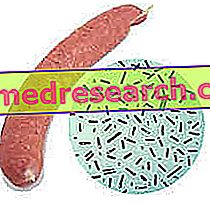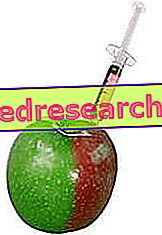Botulinum and Botulism
Botox ( Clostridium botulinum ) is an anaerobic bacterium that can contaminate foods making them particularly dangerous for human health.
The ingestion of these foods causes severe intoxication, known as botulism and characterized by a specific clinical picture. After an incubation period (12-48 hours up to 8 days in exceptional cases) symptoms such as nausea, vomiting, diarrhea and severe muscle pain appear; follow important neurological problems, dry mouth and respiratory tract, visual changes, speech and swallowing disorders.
The rapid aggravation of the already precarious general conditions can lead to death by respiratory paralysis and consequent asphyxia.
Insights on Botulism
Botulism: what forms exist? Infant Botulism Food Botulism: Botulinum Consequences: Foods at Higher Risk Conservation in Oil and Botulinum Symptoms Botulism Botulism: How Botulinum is Diagnosed: Rules to Avoid Risks Drugs to Treat Botulism Botulinum in Aesthetic Medicine Botulinum Alternatives Excessive Sweating: the Strategy of BotoxAlthough the disease is not contagious, only one gram of toxins is able to kill ten million people, while a quantity two hundred times higher would be sufficient to destroy the entire humanity.
Botulinum in Foods
The term botulism was coined in 1897 by the doctor E. van Ermengen, who noticed a direct association between the onset of various epidemics and the consumption of sausages (Butulus in Latin).

The presence of Botox in the food is often announced by the swelling of the lid; sometimes there are also alterations (rancidity, appearance of mold, softening), but the extreme danger of the bacterium derives from its ability to proliferate keeping the organoleptic characteristics of the food almost unchanged.
Fortunately, Botox can be defeated with relative ease, as long as a series of behavioral rules are adopted during food preparation and storage. We know, for example, that the toxin is inactivated by heat, oxygen and acidity. The risk of poisoning can therefore be reduced by bringing the food at risk to a boil for at least ten minutes before consumption. Although refrigeration can delay, but not prevent the development of the toxin, it is still important to refrigerate partially prepared foods.
Unfortunately, the botox spores are very heat resistant .
- The simple boiling (reaching 100 ° C) of the food before immersion in oil is not enough to kill the spores (unless it is prolonged for at least 4/5 hours), indeed, it may even have a counterproductive effect. 5-10 minutes of boiling are however considered sufficient to deactivate botulinum toxins; if the product is consumed immediately after boiling, it can therefore be considered safe, while if it is stored it cannot be assured 100% of its safety.
In case of doubt, before consuming a preserve, it is therefore important to repower the closed jar (80 ° C for at least 20/30 minutes) or boil the contents before consuming it.
- To be effective, heat treatment must take place at 121 ° C for at least 3 minutes; similar temperatures can only be reached through the use of a pressure cooker.
- Even if the boiling does not guarantee the healthiness of the food, there are other interventions capable of making a preserve safe. For example the conditions of strong acidity (for example tomato puree and vinegar), high concentrations of sugar (jams and jams) and high concentrations of salt (pickled food in brine) do not allow the development of botulinum.
In this regard, it is recommended to use a cooking liquid at 10/15% sodium chloride (cooking salt - NaCl) and / or containing more than 2% of acetic acid (through the addition of food vinegar, making the appropriate calculations based on what is reported on the label). In jams, on the other hand, it is important that the sugar percentage reaches at least 50/60%.
Lower concentrations of vinegar, salt or sugar may be equally effective if combined with the heat treatment of boiling or pasteurization. Instead, it should reach 121 ° C for at least 3 minutes in the case of non-acid, unsalted, unsweetened and water-rich preserves.
Watch the video
X Watch the video on youtubeIf you perceive signs of the possible presence of toxins (raised lid), before throwing it away, it is good practice to proceed with boiling the food, so as not to disperse the toxins in the environment.
BOTULIN: HOW TO RECOGNIZE IT
Possible warning signs can be: a bulging metal cover, the presence of bubbles, the escape of gas or liquid, the unpleasant smell of rancid butter and the unnatural aspect. In such circumstances, AVOID tasting the product (and if possible open it).
Remember, however, that NOT the presence of Botox and its toxins is associated with these factors.
Since botulinum spores have been found in honey residues used by children with infant botulism, the consumption of this food should be avoided in the first twelve months of life.
In the industrial field specific food preservatives are used, capable of preventing the multiplication of Botox. Thanks to this pretext, some of these substances, particularly nitrites and nitrates, are used to a large extent to enhance the color of the food. Unfortunately, an overdose is particularly harmful not only for botulinum (which would in any case be inactivated at lower concentrations), but also for humans.
Therapy
To learn more: Drugs for the treatment of Botulinum intoxication
Until a few years ago, botulinum intoxications were often deadly (60-70% of cases). Today, thanks to the use of modern assisted artificial respiration techniques and the administration of antibotulin serum (antitoxin), the mortality rate has dropped to 15-20%.
The chances of survival are greater the more timely the diagnosis is; in this case the therapeutic strategies are based, even before the aforementioned interventions, on the administration of purgatives or emetics, which favor the evacuation of toxins present in the digestive tract and not yet absorbed
. Supportive antibiotic therapy involves the administration of penicillin at dosages of 10-20 million IU / day.
In severe cases, complete recovery from botulism requires several months of recovery.



